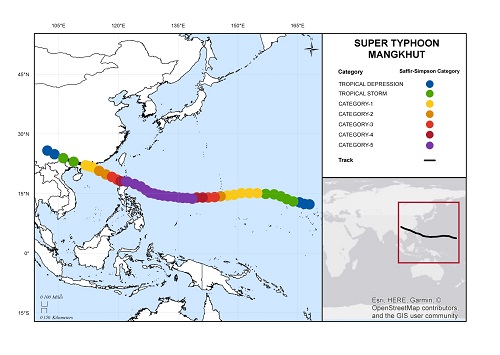
In the West Pacific Basin, Super Typhoon Mangkhut made landfall in Northern Luzon as a Category-5 on the Saffir-Simpson Scale just after 18 UTC September 14, 2018, according to advisories of the Joint Typhoon Warning Center (JTWC). Significant impacts have been reported by media including severe damage due to wind and flooding as well as mudslides. Impacts to agricultural interests in the area have also been reported. After some weakening, Mangkhut then made final landfall just west of Hong Kong as a Category-1 on the Saffir-Simpson Scale just after 06 UTC September 16 in Taishan, according to JTWC and media reports. Considerable impacts due to wind and flooding were reported in Hong Kong, Macau and Guangdong. Media reports indicate at least 70 fatalities as a result of Mangkhut, and our thoughts and concerns are with those lost and affected by this event.
Meteorological Discussion
Mangkhut originated from a disturbance in the West Pacific and was identified as a tropical depression at 00 UTC September 7 by the Joint Typhoon Warning Center (JTWC). The storm was upgraded by the JTWC to a tropical storm at 18 UTC September 7, and then to a typhoon at 00 UTC September 9, with 1-minute sustained winds of around 120 km/hr (75 mph). Mangkhut then passed just north of Guam on September 10 while reaching category-3 intensity on the Saffir-Simpson Scale. Mangkhut then underwent a period of rapid intensification and was classified as a super typhoon by 06 UTC September 11. At 18 UTC September 12 Super Typhoon Mangkhut has reached its peak strength with 1-minute sustained winds of around 290 km/hr (180 mph), a strong category-5 on the Saffir-Simpson Scale. During this time, Mangkhut followed a general track to the west-northwest while following the southern edge of a subtropical ridge.

Hazard data illustrated in the GC AdvantagePoint users can view impacted areas on any map as well as see how their portfolios were affected. Please contact your broker or cat modeling analyst for further information.
According to the Joint Typhoon Warning Center (JTWC), Mangkhut reached Luzon in the Northern Philippines just after 18 UTC September 14 as a super typhoon with 1-minute sustained winds of around 270 km/hr (165 mph), category-five on the Saffir-Simpson Scale. The government had issued a Signal 3 warning for areas under threat for flash-floods caused by heavy rainfall, landslides and strong winds. While crossing Luzon, Mangkhut produced unofficial estimates of at least 500 mm (20 inches) of rainfall reported by the media. After clearing the Philippines on September 15 the typhoon had weakened and carried 1-minute sustained winds of around 195 km/hr (120 mph), a category-three on the Saffir-Simpson Scale. The storm continued to produce heavy rainfall over the Northern Philippines as it moved away from the area. Mangkhut then continued on a general west-northwest track while crossing the South China Sea. The storm continued to weaken while approaching the coast near Hong Kong. According to JTWC and media reports, Mangkhut made landfall on the coast of Mainland China just west of Hong Kong. Just prior to landfall at 06 UTC September 16, the JTWC reported 1-minute sustained winds of around 150 km/hr (90 mph), a strong category-1 on the Saffir-Simpson Scale. The storm weakened rapidly after moving inland. Storm surge levels of 3.38 m (11 ft) were unofficially reported by media in Hong Kong, possibly surpassing those of Typhoon Hope (1979).
Impacts
Media reports indicate at least 66 fatalities in the Philippines, mostly in Benguet province due to landslides triggered by heavy rainfall and flooding; this number may increase as search and rescue efforts continue. Considerable property damage was reported including severely damaged and collapsed houses, along with flooding due to heavy rain. Disruption to infrastructure has also been reported including downed power poles. Widespread power outages were reported for affected areas. Impacts have also been reported to agricultural interests in the Province of Cagayan. Reports from the National Disaster Risk Reduction and Management Council (NDRRMC) report that about 600,000 people were affected in 31 provinces in the Philippines. Initial observations indicate that impacts in Luzon may be of lesser degree than Typhoon Haiyan (2013), according to media reports. Mangkhut also rendered considerable impacts to densely populated areas including Hong Kong, Macau and Zhuhai. A typhoon alert of Level 10 (the highest level) was issued for Mangkhut by the Hong Kong Observatory. Media reports indicate at least two fatalities and 200 injuries, and evacuations have affected at least 2.4 million people in Guangdong. Downed trees and power lines were reported along with variable property damage. Damage includes a collapsed construction elevator shaft, damaged bamboo scaffolding as well as broken windows on commercial structures as a result of wind-driven debris. Damage due to storm surge and heavy flooding were also reported. Media reports indicate cancellation of most flights in the Hong Kong, Shenzhen and Guangdong areas and rail, roads and marine routes were also disrupted. Thousands of offshore oil platform workers were evacuated. Casinos in Macau were also closed due to safety concerns.
Sources: BBC, Japan Meteorological Agency, Joint Typhoon Warning Center, Hong Kong Observatory, PAGASA, NDRRMC, Weather Underground, The Weather Company, Associated Press, The Strait Times.